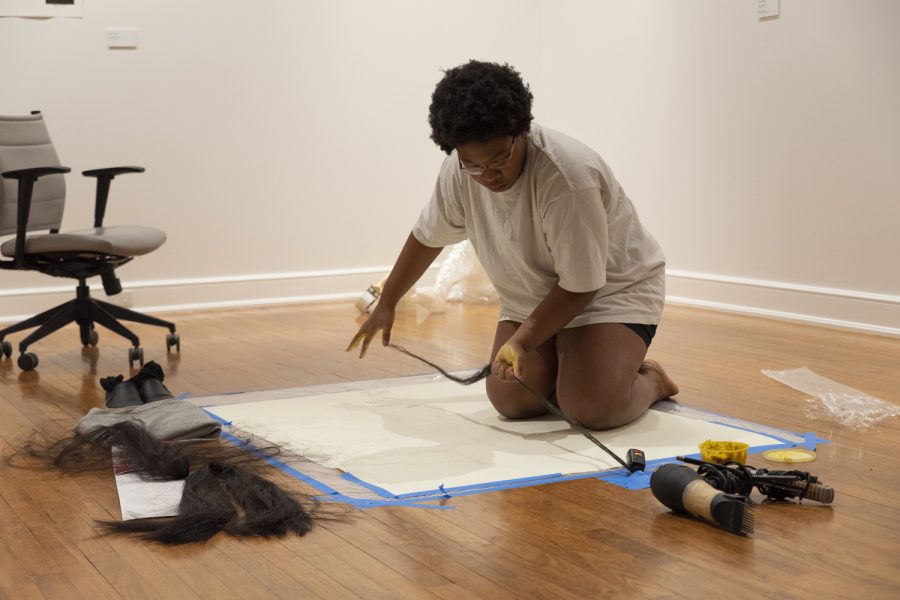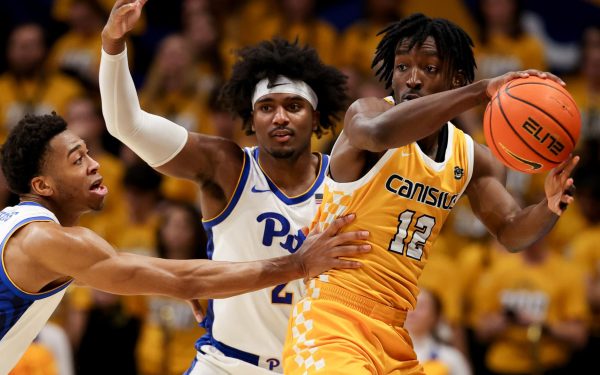Creative Research Exhibition showcases work from summer 2019 fellowships
Brackenridge Fellow Brianna Mims braids hair as part of her performance at the 11th Annual Summer 2019 Creative Research Exhibition.
January 21, 2020
Clad in a T-shirt after removing most of her clothes, Brianna Mims crouched on the floor over a blank sheet of white paper over a length of braiding hair in front of a crowd in the Frick Fine Arts Gallery last week. With her hands coated in shea butter, she braided the hair tightly together until it stretched across the page, leaving behind shea butter stains and loose knots of hair. Upon finishing the braid, she stood and walked out of the gallery.
This performance, as well as other works of visual art, were featured at the 11th Annual Summer 2019 Creative Research Exhibition, which opened this past Thursday. The exhibition presents the works of six artists who pursued summer research opportunities through the University Honors College. The works displayed the efforts of four participants from the Studio Arts Wyoming Field Study as well as two Brackenridge Fellows.
The Studio Arts field study offers students the opportunity to travel to Wyoming and dive head first into working full-time on their artwork. With inspiration from the landscape and help from professors from Pitt and the University of Wyoming, students have the opportunity to create works of art. The Brackenridge Fellowship offers students funding for a summer-long creative research project of their choosing.
As Delanie Jenkins, chair and professor in the Studio Arts Department, describes it, “creative research” isn’t all that different from biomedical or historical research.
“Sometimes [creative research] can be just testing the material or the processes, or it might be placing themselves in a condition in which they’ve never worked before and seeing what they can do,” Jenkins said.
The art created by Brackenridge Fellows Mims, a junior studio arts and psychology major, and Eli Savage, junior studio arts major and layout editor for The Pitt News, intended to do just that. Mims created pieces discussing the black female identity, including the texture of hair. For first-year Celia Maiers Cubas, the performance reminded her of what she learned in classes for her classics major.
“It’s interesting to me that a lot of the human experience and things that humans think about and are passionate about hasn’t really changed throughout time, and I think this is a good example of that,” Maiers Cubas said.
In her artist’s statement, Mims explained that a “sense of identity” never came easily to her a child and she felt ashamed and insecure about her thick, coily hair. Her adolescent experience has since inspired her to investigate her current identity through art. As an adult, she felt that the internalized pressure to “perform for a white audience” was less intense, so she started to tell her own story through her hair.
“In my artistic practice, I stay open to a variety of mediums. The richness of the black female identity inspires my artistic intentions. A copious variety of textures, colors, tools, and techniques. Whether using pastels, clay, or literal hair, I investigate ideas of perception, adornment, and performance,” she wrote.
Mims’ pieces explored black female identity through several visual mediums beyond her live performance, including photography. Her exhibit included pictures of her nieces having their hair done, as well as self-portraits. One self-portrait played with perception and appearances, as Mims’ appearance was split between one side wearing a pink dress, with straightened hair and makeup, while the other side of her wore a black jacket and had an unadorned face and hair in a ponytail.
Savage’s pieces highlighted the intimate story of his transition as a transgender male. One of his works was a comic outlining the difficult and scary journey of transitioning while still celebrating the beautiful aspects of being transgender and honoring who you are.
In his artist statement, Savage admits that his focus on his male identity felt “incongruent with [his] new visualization of gender as scattered and intangible,” and for this reason chose to create abstract pieces to represent his struggle to grapple with the complex origins of the transgender identity.
While the Brackenridge Fellows’ work focused on personal identity, art created by participants in the Wyoming field study program veered more toward the natural world. According to Jenkins, the program was designed to bring research and art together by putting the artists in a completely new environment. The students lived and sometimes camped in rural areas, doing their work in buildings with no running water. She said by altering the conditions that they were exposed to, the artists had to adapt their techniques and ideas to match their new surroundings.
“Your ink or paint will dry must faster than you’re used to,” said Jenkins. “Really all of the conditions are different, so you have to work with little to no humidity there whereas here there’s more humidity.”
By studying their surroundings in Wyoming, the four artists who went created pieces inspired by the landscape and wildlife they encountered. One piece, produced by artist Azize Altay Harvey, a Japanese and studio arts double major, showcased the difficult nature of producing art in this setting. Harvey’s piece featured animal bones that were harvested from the carcass of an animal that Harvey found. Jenkins said she and Harvey worked together to process the bone and turn it into art.
“We learned how to cook it so we could get all of the stuff off of it and how to treat it and how to handle it,” Jenkins said. “And it was very difficult in a lot of different ways.”
Harvey’s other works featured a bone that had been embossed with reflective plates. A picture of it sitting on a sand dune was also on display, alongside photographs of the animal carcasses and landscapes of Wyoming. Harvey’s artist statement detailed the way she saw death up close in a way she was unfamiliar with while working in Wyoming. This became the basis for her art.
While in Wyoming, Alex McDonough, a senior biology and studio arts double major, was inspired to create works to honor the pronghorn, also known as the Wyoming Antelope. One of her works, titled “Pronghorn’s Flora,” consisted of papers on the data and conservation laws that protected the pronghorn. On top of these papers she painted pictures of the plants that the pronghorn ate and the microscopic flora that lives in the animal’s gut.
“I was just drawn to [the pronghorn] because it looked like something from a sci-fi movie,” McDonough said. “I get interested in phages or the immune system and then I just attack it from a lot of different perspectives in order to try to open it up and do research on it.”
Most of her research on the animal came from collaborations with the biology department at the University of Wyoming. Through this work, McDonough was also inspired to create jars of botanical dyes and embossments of some of the plants the pronghorn ate. She was also able to create a digital display featuring the pronghorn and images of bustling society as well.
“I think the significance of research in general is that you gain inspiration and value from research,” McDonough said. “For artists, it is almost like you can view an object from a different perspective entirely.”
Editor’s note: This article has been updated to correct some inaccurate language and descriptors in the representation Brianna Mims’ performance and artwork, and to include information clarifying the intention of her exhibition. The Pitt News regrets these errors.








